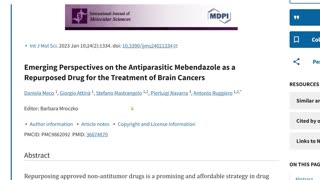Premium Only Content

Mystery pneumonia and vitamin A
Vitamin A (which is retinol) and immunity
WHO report
https://www.who.int/emergencies/disease-outbreak-news/item/2023-DON494
https://www.nhs.uk/conditions/vitamins-and-minerals/vitamin-a/
Vitamin A has several important functions
helping natural defence against illness and infection (immune system) work properly
helping vision in dim light
keeping skin and the lining of some parts of the body, such as the nose, healthy
Good sources of vitamin A
Good sources of vitamin A (retinol) include:
cheese
eggs
oily fish
fortified low-fat spreads
milk and yoghurt
liver and liver pâté
If you're pregnant you should avoid eating liver or liver products, (NHS, 2023)
Excess vitamin A is toxic.
Vitamin A deficiency
https://www.who.int/data/nutrition/nlis/info/vitamin-a-deficiency
What are the consequences and implications?
Night blindness is one of the first signs of vitamin A deficiency.
In its more severe forms, vitamin A deficiency contributes to blindness by making the cornea very dry, thus damaging the retina and cornea.
An estimated 250 000–500 000 children who are vitamin A-deficient become blind every year,
and half of them die within 12 months of losing their sight.
World’s leading preventable cause of childhood blindness.
Deficiency of vitamin A is associated with significant morbidity and mortality from common childhood infections,
Vitamin A deficiency also contributes to maternal mortality and other poor outcomes of pregnancy and lactation.
It also diminishes the ability to fight infections.
Even mild, subclinical deficiency can be a problem, because it may increase children's risk for respiratory and diarrhoeal infections,
decrease growth rates,
slow bone development and decrease the likelihood of survival from serious illness.
Beta carotene
Red-orange pigment, in plants and fruits,
especially carrots and colourful vegetables.
The body converts beta carotene into vitamin A
The advantage of dietary beta carotene is that the body only converts as much as it needs.
Healthy antioxidant
May prevent cognitive decline
https://jamanetwork.com/journals/jamainternalmedicine/fullarticle/769551
May help lung function
https://thorax.bmj.com/content/61/4/320
Both may be due to preventing oxidative stress
https://www.medicalnewstoday.com/articles/252758#_noHeaderPrefixedContent
Foods rich in beta carotene:
Apricots, Asparagus, Broccoli, Carrots, Chives, Dandelion leaves, Grapefruit, (Chilli powder, oregano, paprika, parsley), Kale,
Onions, Peas, Peppers, Plums, Pumpkin, Spinach, Squash, Sweet potatoes.
Role of Vitamin A in the Immune System
https://www.ncbi.nlm.nih.gov/pmc/articles/PMC6162863/
Needed for mucous membrane innate immunity (respiratory and GI)
Essential for the normal function of many immune cells such as T lymphocytes
Vitamin A deficiency is associated with severe Mycoplasma pneumoniae pneumonia in children
Beijing, Feb, 2020
N = 122 children, (0 – 15)
52 sMPP
Severe Mycoplasma pneumoniae pneumonia
70 nsMPP
Non-severe Mycoplasma pneumoniae pneumonia
Serum levels of vitamins A, D, and E were measured and compared, and correlated with nsMPP and sMPP.
Results
The age was older in the sMPP samples than that in the nsMPP samples.
(7.12 vs. 4.01)
So older children suffered more severe infections.
Vitamin A deficiency was present in both the nsMPP and sMPP samples.
Vitamin A levels were significantly lower in the sMPP serum than that in the nsMPP serum.
(0.15 vs. 0.19)
Vitamin A deficiency was defined
Deficiency, <0.2 mg/L,
Subclinical vitamin A deficiency, 0.2–0.3 mg/L
Normal vitamin A level by 0.3–0.7 mg/L.
So, children with lower vitamin A levels suffered more severe infections.
Vitamins E and D levels were also lower in sMPP children
Vitamin E (7.4 vs. 8.22)
Vitamin D (23.08 vs. 32.07)
Both sMPP and nsMPP did not show a deficiency of vitamins E and D.
Vitamin A deficiency OR 0.001 – 0.334, (P=0.009) associated with sMPP
Incidence of vitamin A deficiency
Vitamin A deficiency in under 6 years was 85% of children
Vitamin A deficiency in over 6 years was 62.5% of children
Vitamin A supplementation could reduce the incidence of sMPP.
Conclusions
Vitamin A deficiency is associated with sMPP and more likely present in the younger sMPP children.
Therefore, it is important to monitor and supplement vitamin A in Mycoplasma pneumonia patients.
Extra details
Mycoplasma pneumoniae (MP) frequently causes community-acquired pneumonia in children
Occurs throughout the year.
Can be transmitted by droplets
Children of all ages are susceptible
In recent years, the number of children with MP pneumonia has increased,
and they have a prolonged course of the disease.
Typical symptoms
Fever, wheezing, difficulty in breathing, chest pain, and chills.
MPP, particularly refractory or severe MPP, often result in pleural effusion, atelectasis, and another organ damage.
Vitamin deficiencies lead to a higher incidence of respiratory
and digestive diseases in patients, particularly in children.
Vitamins also have a significant impact on disease prognosis.
Our findings show that vitamin A deficiency was significantly correlated with sMPP, and more likely occurred in the younger children.
Vitamin A plays an important pleiotropic role in supporting the normal mucosal barrier,
with the result of the increase of the risk of invasive pathogens.
Children who presented vitamin A deficiency were more likely to get an acute respiratory tract infection and diarrhea.
Vitamin A regulates cytokine
The functions of macrophages, neutrophils and natural killer cells were impaired,
and the protective function of the respiratory mucosa was also decreased in the deficiency of vitamin A.
Vitamin A deficiency can lead to changes in the extracellular matrix and basement membrane protein content and distribution.
Vitamin A deficient rats have thicker alveolar basement membranes
The incidence and severity of infectious diseases are increased in vitamin A deficient children.
Epidemiological surveys show that the incidence of vitamin A deficiency is significantly associated with age;
the younger the age, the higher the incidence of vitamin A deficiency.
Vitamin A deficiency was associated with sMPP, and the supplementation of vitamin A may reduce the occurrence of sMPP in children.
Several studies also showed that supplementation of vitamin A could reduce the incidence of respiratory infections and shorten the course of the disease.
Vitamin A deficiency was more likely present in younger sMPP children,
suggesting that supplementation of vitamin A is more important in younger children who have potential MP infection.
In our study, although we did not find a significant correlation between vitamins E and D levels with nsMPP and sMPP, vitamins E and D should be maintained at least at the normal levels.
-
 19:30
19:30
Dr. John Campbell
16 days agoWorm meds for cancer
37.8K263 -
 LIVE
LIVE
MDGgamin
3 hours ago🔴LIVE- Wake Up Stream Repeat - Games & Chatting - #RumbleTakeover
173 watching -
 1:38:13
1:38:13
Mostly Sports With Mark Titus and Brandon Walker
22 hours agoThe World Needs More Jameis Winston & Bo Nix | Mostly Sports EP 302 | 12.3.24
15.2K2 -
 DVR
DVR
TheAlecLaceShow
4 hours agoDoes Racism Exist? Guest: Franck Zanu | Elon’s Viral Meme | Hunter Pardon | The Alec Lace Show
5.07K2 -
 LIVE
LIVE
G2G Gaming Channel
6 hours agoI heard Smite, So Im here! #RumbleTakeOver #RumbleGaming
136 watching -
 15:36
15:36
Neil McCoy-Ward
2 hours ago🚨 Emergency Martial Law Declared, Special Forces Deployed...
12.7K5 -
 1:57:30
1:57:30
The Charlie Kirk Show
2 hours agoDemocrat Billionaires in Crisis + Fixing the Migrant Crisis | Blagojevich, O'Brien, Metaxas| 12.3.24
51.5K7 -
 1:01:07
1:01:07
The Dan Bongino Show
5 hours agoBiden’s Reign Of Destruction Isn’t Over Yet (Ep. 2381) - 12/03/2024
611K1.49K -
 1:59:02
1:59:02
Steven Crowder
5 hours ago🔴 COVID Chronicles: The Hidden Truths of the Pandemic Exposed
336K200 -
 LIVE
LIVE
SoundBoardLord
3 hours agoMulti-Gen Don Juan in Full Force!
162 watching